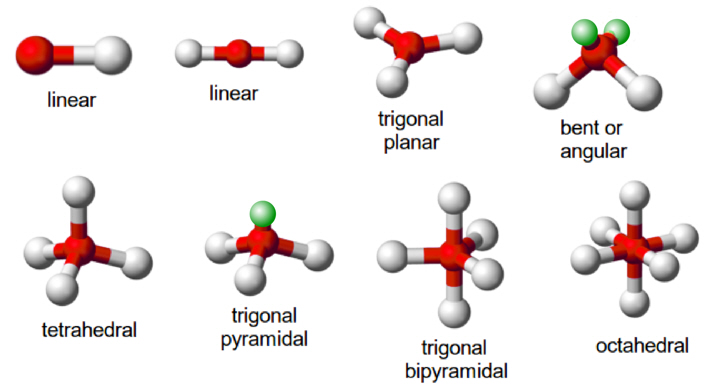Chemical Bonding and Shape of Molecules



↪ The attractive force between a hydrogen atom and strong electronegative atom (Such as N, F and O) of same or different molecules is called hydrogen bond.
↪ It is denoted by dotted lines.
Types of Hydrogen Bonding
There are two types of H bonds, and it is classified as the following:
Intermolecular Hydrogen Bonding
↪ The force of attraction between H already bonded with highly electronegative element (F or O or N) and highly electronegative element (F, O or N) of different molecule is called intermolecular hydrogen bond.
For example – hydrogen bonding in water, alcohol, ammonia etc.
↪ Hydrogen Bonding in Hydrogen fluoride
Fluorine having the highest value of electronegativity forms the strongest hydrogen bond.
↪ Hydrogen Bonding in Water
A water molecule contains a highly electronegative oxygen atom linked to the hydrogen atom. Oxygen atom attracts the shared pair of electrons more and this end of the molecule becomes negative whereas the hydrogen atoms become positive.

↪ Hydrogen Bonding in Ammonia
It contains highly electronegative atom nitrogen linked to hydrogen atoms.

↪ Hydrogen Bonding in Alcohols and Carboxylic acid
Alcohol is a type of an organic molecule which contains an -OH group. Normally, if any molecule which contains the hydrogen atom is connected to either oxygen or nitrogen directly, then hydrogen bonding is easily formed Hydrogen Bonding in Alcohols
Hydrogen Bonding in Alcohols Hydrogen Bonding in Carboxylic acid
Hydrogen Bonding in Carboxylic acid
Intramolecular Hydrogen Bonding
↪ Force of attraction between the hydrogen (which is already bonded with highly electronegative element) and highly electronegative (F or O or N) element of same molecule, is called intramolecular hydrogen bond.
Effects of Hydrogen Bonding on Elements
⁕ Association
↪ The molecules of carboxylic acids exist as dimer because of the hydrogen bonding.
↪ The molecular masses of such compounds are found to be double than those calculated from their simple formula.
⁕ Dissociation
↪ In aqueous solution, HF dissociates and gives the difluoride ion instead of fluoride ion. This is due to hydrogen bonding in HF.
The molecules of HCl, HBr, HI do not form a hydrogen bond. This explains the non-existence of compounds like KHCl2, KHBr2, KHI2.
Properties of Hydrogen Bonding
⁕ Solubility:
↪ Lower alcohols are soluble in water because of the hydrogen bonding which can take place between water and alcohol molecule.
⁕ Volatility:
↪ As the compounds involving hydrogen bonding between different molecules have a higher boiling point, so they are less volatile.
⁕ Viscosity and surface tension:
↪ The substances which contain hydrogen bonding exists as an associated molecule. So their flow becomes comparatively difficult.
↪ They have higher viscosity and high surface tension.
⁕ The lower density of ice than water:
↪ In the case of solid ice, the hydrogen bonding gives rise to a cage-like structure of water molecules.
↪ As a matter of fact, each water molecule is linked tetrahedral to four water molecules.
↪ The molecules are not as closely packed as they are in a liquid state.
↪ When ice melts, this case like structure collapses and the molecules come closer to each other.
↪ Thus for the same mass of water, the volume decreases and density increases.
↪ Therefore, ice has a lower density than water at 273 K. That is why ice floats.